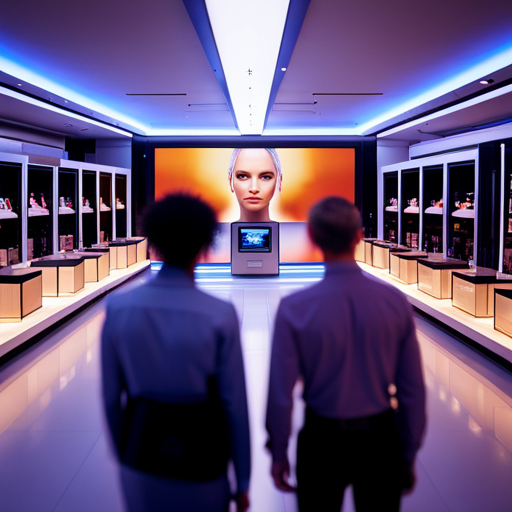Are you curious about how AI and robotics are transforming the job market? Well, buckle up because the future of work is here!
With automation on the rise, job roles and skills are being impacted like never before. From manufacturing to customer service, AI and robotics are revolutionizing every industry. Even healthcare is undergoing a major transformation.
But with these advancements come ethical and social implications that we must navigate. Join us as we explore the exciting and challenging world of the future of work.
Key Takeaways
– Automation is drastically changing job roles and skills
– AI is reshaping job roles and skills
– Automation has transformed the manufacturing industry
– AI and robotics have transformed customer service and support
The Rise of Automation in the Workplace
@ Midjourney AI Image Prompt: /imagine prompt:Create an image showcasing a diverse workforce of humans collaborating with advanced robots in a modern office environment. Show robots assisting in various tasks, symbolizing the increasing role of automation in shaping the future of work. –v 5.2 –ar 16:9
The rise of automation in the workplace is drastically changing the way jobs are performed. As technology advances, more and more tasks that were once done by humans are now being taken over by machines. This shift has both positive and negative implications for workers.
On the positive side, automation can increase efficiency and productivity. Machines are often faster and more accurate than humans, allowing tasks to be completed more quickly and with fewer errors. This can free up time for workers to focus on more complex and creative aspects of their jobs.
However, the rise of automation also poses challenges for workers. Jobs that can be easily automated are at risk of being replaced by machines. This can lead to job loss and unemployment, particularly for workers in industries that are heavily reliant on manual labor.
To adapt to these changes, workers need to develop new skills that are in demand in the age of automation. This might mean learning to work alongside machines, or acquiring skills that cannot be easily automated, such as critical thinking, problem-solving, and emotional intelligence.
The Impact of AI on Job Roles and Skills
@ Midjourney AI Image Prompt: /imagine prompt:Create an image illustrating a diverse group of workers equipped with futuristic tools collaborating seamlessly with AI and robots, showcasing the transformative impact of AI on job roles and the need for new skills in the evolving job market. –v 5.2 –ar 16:9
You’ll need to adapt your job roles and skills due to the impact of AI. Artificial Intelligence (AI) is revolutionizing the job market, and it’s crucial to stay ahead of the game. Here are three key ways AI is reshaping job roles and skills:
– Automation of routine tasks: AI can automate repetitive and mundane tasks, freeing up your time to focus on more complex and strategic work. This means that you will need to develop skills that complement AI, such as critical thinking, problem-solving, and creativity.
– Increased demand for tech skills: As AI becomes more prevalent, there will be a growing demand for professionals with technical skills. Learning programming languages, data analysis, and machine learning will give you a competitive edge in the job market.
– Embracing collaboration with AI: Instead of seeing AI as a threat, it’s important to view it as a tool that can enhance your work. Collaborating with AI systems can improve efficiency and productivity. Developing skills in working alongside AI will be crucial for future job roles.
Robotics and the Future of Manufacturing
@ Midjourney AI Image Prompt: /imagine prompt:Create an image that depicts a futuristic manufacturing floor filled with autonomous robots performing intricate tasks, while human workers collaborate with them using advanced technologies, illustrating the harmonious coexistence of humans and robots in the future of manufacturing. –v 5.2 –ar 16:9
In today’s discussion, we will explore the topic of automation in factories and its impact on employment.
Automation, such as the use of robotics, has significantly transformed the manufacturing industry. It has led to increased efficiency and productivity.
However, it has also raised concerns about job displacement and the future of employment in factories.
Automation in Factories
Robots and AI are revolutionizing factories by automating tasks previously done by humans. Now, you might be wondering how exactly this automation is taking place. Well, let me break it down for you. In today’s factories, robots and AI systems are being used to perform a wide range of tasks, from assembly line work to quality control. Take a look at the table below to get a better idea of the specific tasks that are being automated:
| Task | Previous Human Involvement | Current Automation |
|---|---|---|
| Assembly Line | Manual labor | Robot arms |
| Quality Control | Human inspection | AI algorithms |
| Packaging | Human workers | Automated systems |
| Inventory | Manual counting | RFID technology |
| Maintenance | Human technicians | Self-diagnosis |
As you can see, automation is transforming the factory landscape, making it more efficient and cost-effective. So, don’t be surprised if you walk into a factory and find robots and AI systems working alongside humans. It’s the future of manufacturing, and you’re witnessing it firsthand.
Impact on Employment
Automation in factories has sparked concerns about the impact on employment. As you look into the future, it’s natural to wonder how this technological shift will affect your livelihood. Here are three key insights to help you understand the implications:
1. Job displacement: With the rise of automation, certain tasks that were previously performed by humans will now be taken over by machines. This could lead to job losses in traditional manufacturing roles.
2. New job opportunities: While automation may eliminate some jobs, it also opens up new avenues for employment. As technology advances, there will be a growing need for workers who can design, program, and maintain these automated systems.
3. Reskilling and upskilling: To stay relevant in the changing job market, it’s crucial to adapt and acquire new skills. Upskilling in areas like data analysis, artificial intelligence, and programming can help you thrive in the era of automation.
AI and Robotics in Customer Service and Support
@ Midjourney AI Image Prompt: /imagine prompt:Create an image showcasing a customer service representative interacting with a humanoid robot, both wearing headsets and collaborating seamlessly. The robot displays advanced facial recognition technology, reflecting a harmonious blend of AI and human assistance in customer support. –v 5.2 –ar 16:9
AI and robotics have significantly transformed the way customer service and support are handled. With the advancements in technology, companies are now employing intelligent chatbots and automated systems to provide efficient and personalized customer experiences. These AI-powered bots are capable of understanding and responding to customer queries in real-time, eliminating the need for human intervention in many cases.
One of the major benefits of AI and robotics in customer service is the ability to provide round-the-clock support. Unlike human agents, AI-powered systems can work tirelessly 24/7, ensuring that customers receive assistance whenever they need it. This not only improves customer satisfaction but also helps businesses save on labor costs.
AI and robotics also play a crucial role in streamlining support processes. These technologies can analyze large volumes of customer data, identify patterns, and generate insights that can be used to improve products and services. Additionally, AI-powered systems can automate repetitive tasks such as order tracking, appointment scheduling, and issue resolution, freeing up human agents to focus on more complex and value-added tasks.
Furthermore, AI and robotics enable businesses to offer personalized and proactive support. By utilizing machine learning algorithms, these systems can analyze customer behavior, preferences, and past interactions to deliver targeted recommendations and anticipate customer needs. This level of personalization helps to build stronger customer relationships and enhance brand loyalty.
The Changing Landscape of Healthcare With AI and Robotics
@ Midjourney AI Image Prompt: /imagine prompt:Create an image of a robotic arm delicately performing a surgery, while an AI-powered monitor analyzes patient data in the background. Show the seamless integration of technology and healthcare, symbolizing the changing landscape of healthcare with AI and robotics. –v 5.2 –ar 16:9
With the implementation of AI and robotics, healthcare professionals are experiencing a shift in the way they provide patient care and support. You are now witnessing the changing landscape of healthcare, where these advanced technologies are revolutionizing the industry.
AI algorithms and robotic systems are being utilized to enhance the accuracy and efficiency of diagnostics, enabling faster and more precise treatment plans. These innovations are also streamlining administrative tasks, allowing you to spend more time with patients and focus on delivering personalized care.
As a healthcare professional, you are now collaborating with AI and robotics to improve patient outcomes. AI-powered chatbots are being used to provide immediate assistance and guidance to patients, relieving some of the burden on your shoulders. Robotic surgical assistants are assisting in complex surgeries, minimizing human errors and reducing recovery time for patients. Additionally, AI algorithms are analyzing vast amounts of patient data to identify patterns and detect early signs of diseases, leading to proactive and preventive healthcare.
However, while AI and robotics offer numerous benefits, it is crucial for you to adapt and learn how to effectively work alongside these technologies. You must become proficient in using AI-powered tools and systems to ensure seamless integration into your daily workflow. Embracing these advancements will not only enhance patient care but also empower you to stay at the forefront of the evolving healthcare landscape.
Navigating the Ethical and Social Implications of AI and Robotics in the Job Market
@ Midjourney AI Image Prompt: /imagine prompt:Create an image that depicts a diverse group of individuals engaged in meaningful discussions around a table, surrounded by futuristic AI and robotic technologies. Show expressions of concern, curiosity, and collaboration, capturing the ethical and social dimensions of AI and robotics in the job market. –v 5.2 –ar 16:9
Now that we’ve explored the changing landscape of healthcare with AI and robotics, let’s dive into the ethical and social implications of these technologies in the job market. As you navigate this complex terrain, it’s important to consider the following:
1. Job displacement: With the rise of AI and robotics, certain jobs may become automated, leading to potential unemployment. This raises questions about the responsibility of companies and governments in supporting those affected by these technological advancements.
2. Skills gap: As AI and robotics become more prevalent, new skills will be required to work alongside these technologies. It’s crucial to invest in education and training programs to bridge the gap and ensure individuals are equipped with the necessary skills to thrive in the future job market.
3. Bias and fairness: AI algorithms are only as unbiased as the data they are trained on. It’s essential to address and mitigate any biases that may be embedded in these systems to ensure fairness and equal opportunities for all.
4. Privacy and data security: AI and robotics generate vast amounts of data, raising concerns about privacy and data security. Safeguarding personal information and implementing robust data protection measures are crucial in navigating the ethical implications of these technologies.
Frequently Asked Questions
How Will AI and Robotics Impact Job Security in the Future?
AI and robotics will greatly impact job security in the future. You will need to adapt and acquire new skills to stay relevant in the changing job market. Embrace the opportunities they bring.
What Are the Potential Risks and Challenges Associated With the Increasing Use of AI and Robotics in the Job Market?
The potential risks and challenges associated with the increasing use of AI and robotics in the job market include job displacement, skills gaps, and ethical implications. It is important to address these issues to ensure a smooth transition.
Will AI and Robotics Replace Human Workers Completely, or Will They Simply Augment Human Capabilities?
Will AI and robotics replace you entirely, or will they just enhance your skills? It’s a complex issue with potential risks and challenges involved. But don’t worry, there’s still a place for you in the future job market.
How Can Individuals Prepare Themselves for the Changes Brought About by AI and Robotics in the Job Market?
To prepare for the changes brought about by AI and robotics in the job market, you should focus on developing skills that are difficult to automate, such as creativity, critical thinking, and emotional intelligence.
What Are the Potential Ethical Concerns Surrounding the Use of AI and Robotics in the Workplace, and How Can They Be Addressed?
The potential ethical concerns surrounding the use of AI and robotics in the workplace include privacy, job displacement, and bias. These concerns can be addressed through proactive regulation, transparency, and responsible use of technology.
Conclusion
In conclusion, you can expect significant changes in the job market as AI and robotics continue to shape the future of work. Automation is on the rise, impacting job roles and requiring new skills.
Manufacturing, customer service, and healthcare industries are already experiencing the transformative power of AI and robotics. However, it is essential to navigate the ethical and social implications that come with these advancements.
Embracing the potential of AI and robotics while ensuring responsible implementation will be key in shaping a successful future workforce.



